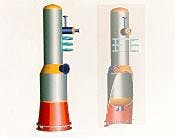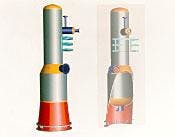Updated pressure vessel software
Newly released PVElite Version 5.00 is an updated edition of an integrated vessel design and stress analysis software that incorporates the latest ASME 2002 Addenda for pressure vessels and includes revised databases.
Version 5.00 integrates 3D graphics into input for easier and faster modeling and adds sump element and nozzle-on-nozzle capabilities. The new version lets you save input data to an ODBC database such as Microsoft Access to make it easier to share and manage information, and the new color syntax highlighting in the output allows users quickly to find errors and create attractive reports. It also incorporates new capabilities for British Standard PD 5500 including the Annex C fluctuating pressure fatigue analysis.
For faster component analysis, the updated program adds a flange merge capability, and to make the analysis of tube sheets easier, the new version integrates the tube sheet with the expansion joint and adds PD 5500 calculations for u-tube, floating, and fixed tube sheets.
For greater accuracy when analyzing nozzles, CodeCalc now checks to see if the nozzle is outside the spherical portion of the head and lets you perform area calculations on small nozzles at each nozzle level. Other enhancements include the addition of a British material database in WRC 297, Annex G and the tube sheet modules and Fitness For Service API 579, which evaluates local thinning and general metal loss at various levels. It also incorporates A-2002 changes for pressure vessel components.
In addition to these new features, PVElite incorporates current pressure vessel codes and standards such as ASME BPV, PD 5500, ASCE #7, Uniform Building Code, National Building Code, ANSI B 16.5, TEMA, and WRC Bulletins 107 and 297.
The program provides complete design of tall towers, horizontal vessels, "pots and pans," and individual vessel components. The software was designed for quick start-up, and its graphical modeling capabilities are easy to use and allow for quick data assembly and vessel analysis, the company says.
Source: COADE Inc., 12777 Jones Rd., Suite 480, Houston, TX 77070.
New web-based data management tool
Corporate Data Archiver, a new web-based data management tool, stores and protects the digital assets of upstream operating companies.
It provides rapid retrieval of critical data and knowledge, and reduces the need to rework projects or reacquire data due to lack or loss of information, the company says.
It stores definitive versions of items such as prospect evaluations or reservoir studies and is designed to record a project visually, automatically creating a snapshot of selected data.
The tool features an easy-to-use interface where users can simply type in a key word or phrase and easily find archived data and project knowledge.
In addition, it consolidates project data and documentation for output to this firm's PetroBank Master Data Store system where project archives can be safely and securely managed or saved to corporate IT disk and tape systems.
Corporate Data Archiver supports the OpenWorks R2003 project data management system. It is built on a vendor neutral framework allowing subsequent releases to support archiving with industry standard formats such as SEGY, LAS, WellLogML as well as support for third-party products and other project management systems. Corporate Data Archiver runs on UNIX and Linux platforms.
Source: Landmark Graphics Corp., Box 42806, Houston, TX 77242.
New integrated plotting aids reservoir modeling
Tecplot RS is a new integrated plotting environment designed specifically for oil reservoir modeling.
Tecplot RS allows data from multiple sources to be loaded and displayed in anything from XY graphs to 3D renderings. The software manages data from multiple reservoir simulators, as well as measured data like field rates and formation tests. It also allows for quick comparisons of simulated and historical data when matching multiple wells.
Users may analyze several reservoir simulator runs in one set of plots, control the number of plots per page, or define customized sets of plots for repeated use. The software's extensive macro language allows automation of plotting operations. These may be accessed interactively or in a batch mode.
Animation of time sequences, another feature, lets users view and record properties such as saturation fronts in 2D or 3D grid views.
Data may be interactively zoomed, rotated, blanked, probed, and sliced to provide freedom in exploring reservoirs. Streamline data can be imported and displayed with standard grid-based simulator solutions.
Source: Amtec Engineering Inc., Box 3633, Bellevue, WA 98009-3633.
New radar gauge promises accurate measurement
This new MCG-1600SFI smart flash infrared radar gauge promises accuracy, low cost, noncontact, and nonintrusive measurement.
The maker says it's suited for liquid level gauging of virtually any corrosive, contaminated, or viscous product.
At the heart of the newly redesigned gauge is a high-speed floating-point digital signal processor for continuous calibration. The gauge also uses crystal controlled phase lock loop technology.
The lightweight radar has as many as six alarm contacts with wireless, simplified calibration using a hand-held infrared device.
Source: L&J Engineering, 5911 Butterfield Rd., Hillside, IL 60612.


